Below, we will explore various flowers that thrive when planted in July, offering distinct qualities that can enhance your garden’s appeal. Let’s dive into each flower’s characteristics, planting tips, and care requirements.
Agastache
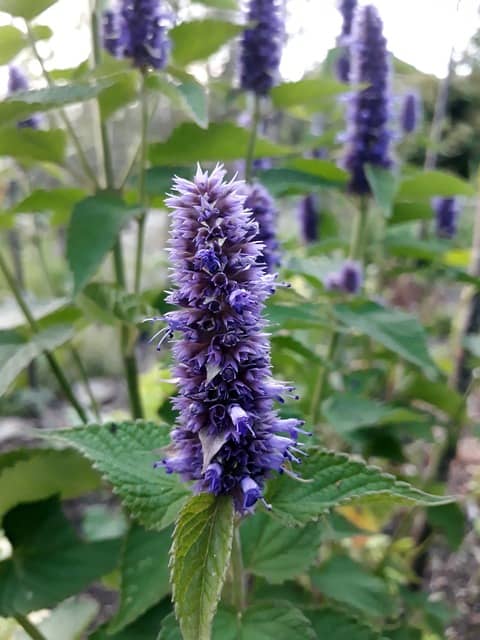
Agastache, commonly known as hyssop or hummingbird mint, is a fantastic choice for July planting. This perennial is particularly adored by pollinators, attracting bees and hummingbirds with its vibrant, tubular flowers. In addition, agastache is drought-resistant, making it an excellent option for low-maintenance gardens.
When choosing a spot for agastache, opt for well-drained soil and full sunlight for the best blooms. These plants can grow up to three feet tall and produce flowers in shades of blue, purple, orange, and pink. Furthermore, they are known for their aromatic foliage, which can add an extra layer of sensory pleasure to your garden.
Aster
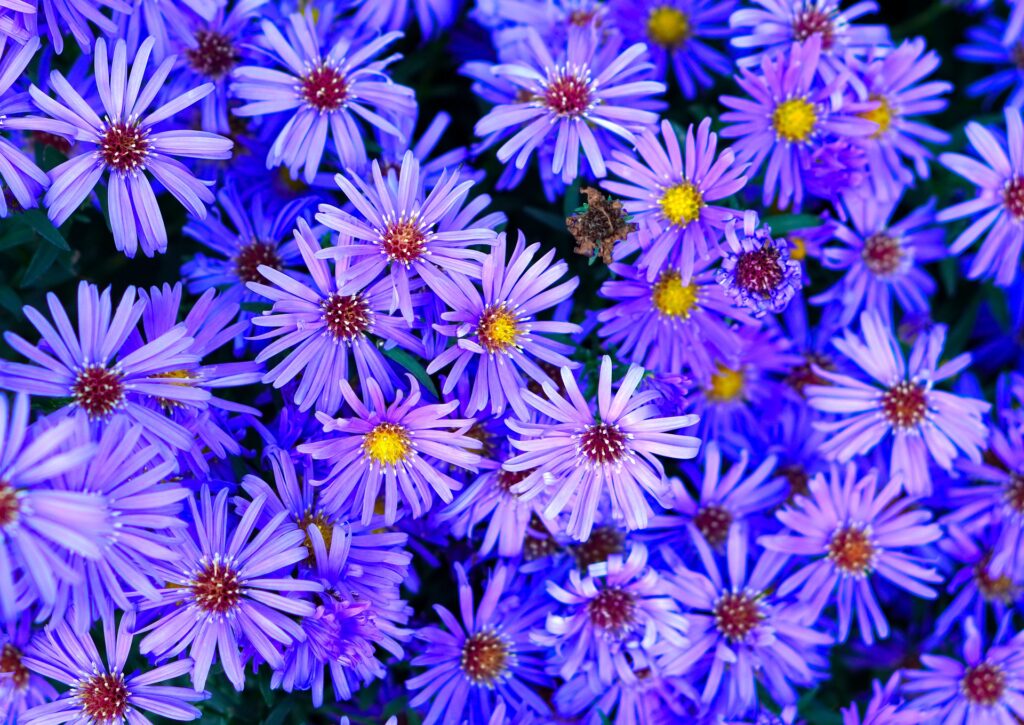
Asters are a fantastic addition to any garden in July, especially as they bloom in the late summer and fall. Offering a burst of color, these perennial flowers range from deep purples to soft pinks and whites. Asters thrive in full sun to partial shade and prefer well-drained soils.
As Asters establish themselves, they will provide reliable color throughout the transition into autumn. With a height ranging from one to three feet, they can be used effectively in borders or as part of a mixed perennial bed. Regular deadheading encourages continuous flowering, ensuring your garden remains vibrant into the cooler months.
Astilbe

Astilbe is the go-to flower for shadier gardens or moist areas, making it a versatile option for July plantings. With feathery plumes of flowers in shades of white, pink, and red, astilbe adds a touch of elegance and texture to your garden.
These perennials thrive in partial to full shade, making them perfect for under trees or in darker spots. They enjoy consistently moist soil, making them an excellent choice for boundaries near water features. With heights ranging from one to four feet, astilbe can be a striking focal point in any shaded area.
Bee Balm
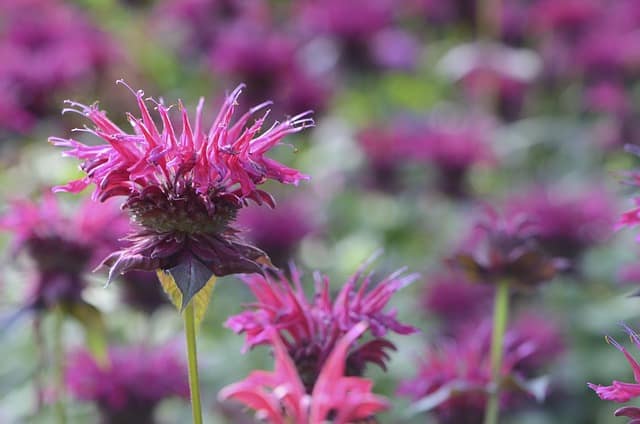
Bee balm, or Monarda, is a lively addition for July gardens reinforcing your commitment to supporting pollinators. With bright blooms in shades of red, pink, and purple, this perennial is not just visually pleasing but also attracts bees, butterflies, and hummingbirds alike.
Bee balm appreciates full sun to partial shade and must have well-drained soils. Its aromatic foliage is not just appealing to pollinators; it can be used in teas or other herbal applications, adding utility to beauty. Additionally, it can grow quite tall (2-4 feet), providing a nice backdrop for smaller flowering plants.
Black-eyed Susan
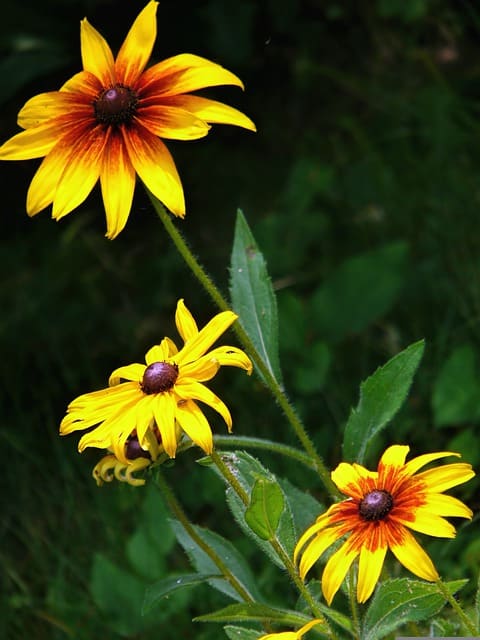
Black-eyed Susans are a well-loved staple in many gardens, boasting bright, daisy-like flowers that bloom from summer through fall. Their gold and brown appearance ensures they catch the sunlight beautifully. They are drought-tolerant and thrive in various soil types yet prefer full sun.
These perennials can reach heights of two to three feet, making them excellent for borders and garden beds. Once established, black-eyed Susans require minimal maintenance, providing a long-lasting display of color. Additionally, their seed heads provide winter interest and nutrition for birds.
Blanket Flower
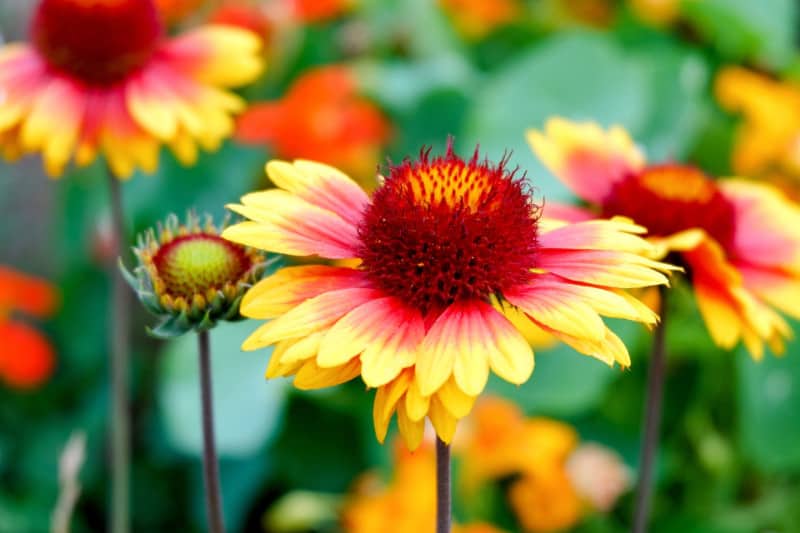
The blanket flower, or Gaillardia, is a joyful bloom characterized by vibrant, fiery colors that make any space feel cheerful. Planting these blooms in July ensures that you will enjoy their bright red and yellow petals all summer long.
These hardy perennials flourish in full sun and well-draining soil, thriving in even dryer conditions. Blanket flowers can spread widely and reach heights of 12 to 30 inches, making them a perfect choice for filling gaps in flower beds or adding color to rocky terrains. Additionally, they are often resistant to adverse environmental conditions, ensuring resilience.
Blazing Star
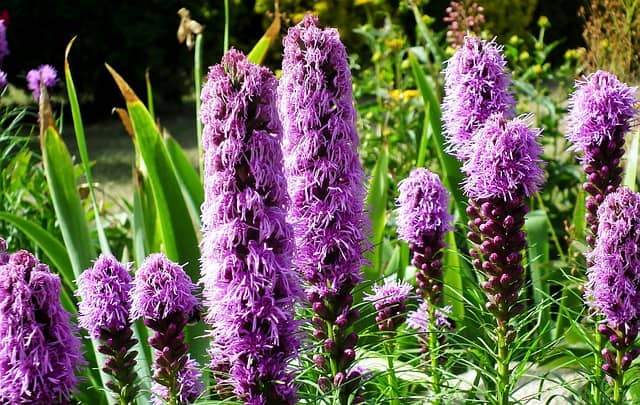
Liatris, also known as blazing star or gayfeather, is an enchanting addition to any garden, especially for those looking for unique, upright blooms that stand out. These tall flowers produce fluffy purple spikes that attract pollinators and provide beautiful vertical interest.
Plant blazing star in full sun and well-draining soil for best results. These perennials are also drought-resistant once established, making them suitable for various garden settings. They typically grow between 2-4 feet tall, contributing to a layered look when partnered with shorter plants.
Catmint

Catmint, or Nepeta, is an aromatic perennial admired for its lovely blue to purple flowers and the delicate fragrance it releases. It’s particularly popular among gardeners for attracting cats and pollinators alike, making it a delightful addition to any garden.
These low-maintenance plants prefer full sun to partial shade and can tolerate poor soil conditions. Catmint typically grows between 12-24 inches in height and provides a long bloom time throughout the summer, helping to fill gaps in the landscape. Regular deadheading encourages bushy growth and abundant flower production.
Celosia (Celosia argentea)

For an invigorating summer splash, plant celosia, known for its striking, flame-like flower heads. Available in various colors such as red, yellow, and orange, celosia is sure to brighten any garden spot.
This annual prefers full sun and well-drained soil and is surprisingly drought-tolerant, making it an effortless yet colorful option for your summer garden. With a height of 12-36 inches depending on the variety, celosia can fill both garden beds and containers robustly, showcasing its bold colors throughout the summer.
Cleome (Cleome hassleriana)
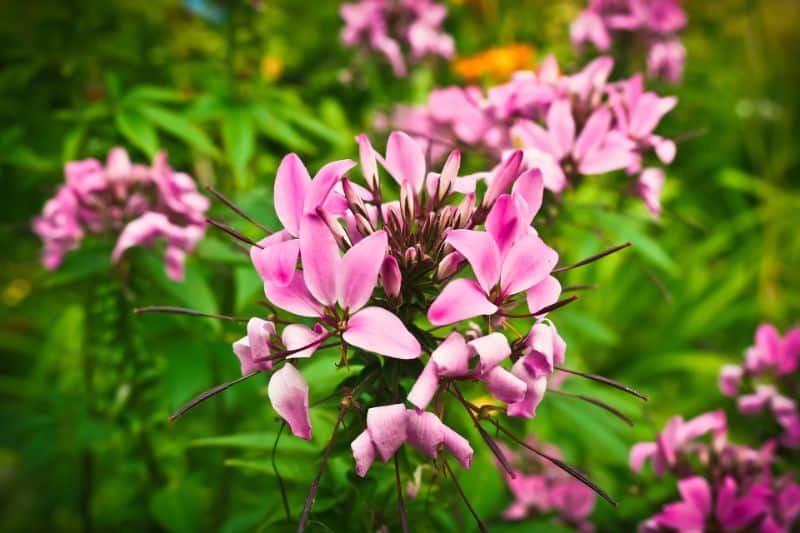
Cleome, or spider flower, brings a unique aesthetic to gardens with its tall spindly stems and clusters of flowers that appear almost like fireworks. These annuals are perfect for gardeners who want a dramatic touch in their summer landscape.
Cleome thrives in full sun and well-drained soil while being adaptable to various conditions. It grows tall (3-5 feet) creating a lovely backdrop for lower-growing plants. Be aware that cleome can self-seed, so if you enjoy its presence, you may see it return in future seasons.
Coreopsis
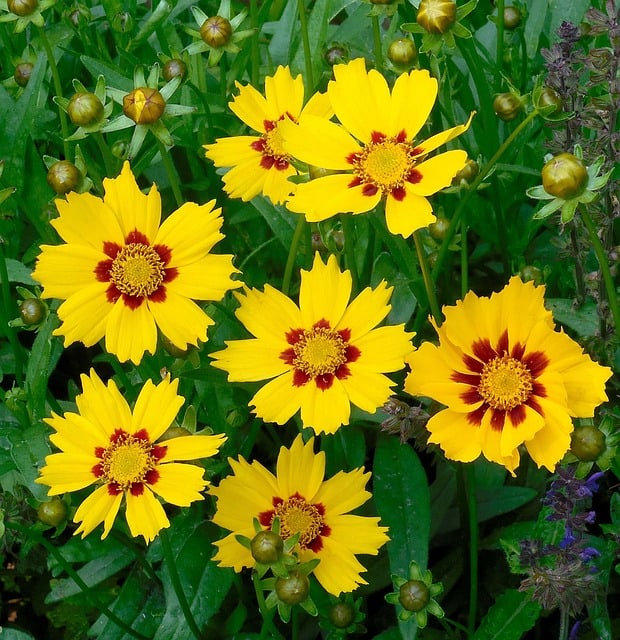
Coreopsis, also known as tickseed, is a cheerful perennial that contributes delightful golden-yellow blooms, ushering summer into full swing. Not only is coreopsis easy to grow, but it also self-sows readily, ensuring its presence year after year.
These perennials thrive in full sun and are tolerant of drought once established. Depending on the variety, coreopsis can grow from 1-3 feet tall, fitting beautifully in borders or mixed flower gardens. Regular deadheading will promote extended blooming throughout the season.
Cosmos (Cosmos bipinnatus)

Cosmos are beloved for their daisy-like appearance and colorful blooms that sway gracefully in the breeze. Available in shades of pink, white, and purple, these annuals add a whimsical charm to any garden.
Plant cosmos in full sun with well-drained soil, and watch them flourish. Typically reaching heights of 2-4 feet, their delicate, thin stems can create a beautiful, airy effect in gardens. Their low-maintenance nature and ability to attract butterflies make them a delightful conversation starter in outdoor spaces.
Echinacea
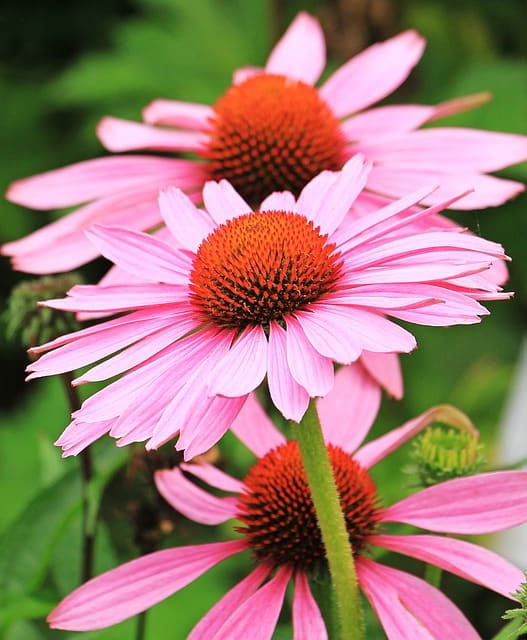
Echinacea, commonly referred to as coneflower, is a popular choice for summer planting due to its vibrant purple, pink, or white blooms. Not only do these flowers bring color, but they also provide medicinal benefits, often used in herbal remedies.
These drought-tolerant perennials prefer full sun and can grow 2-4 feet tall. Echinacea is easy to care for; just ensure well-drained soil is maintained. By attracting pollinators while also serving as a favorite among birds for seed throughout winter, echinacea is a multi-functional star in your garden.
Foamflower
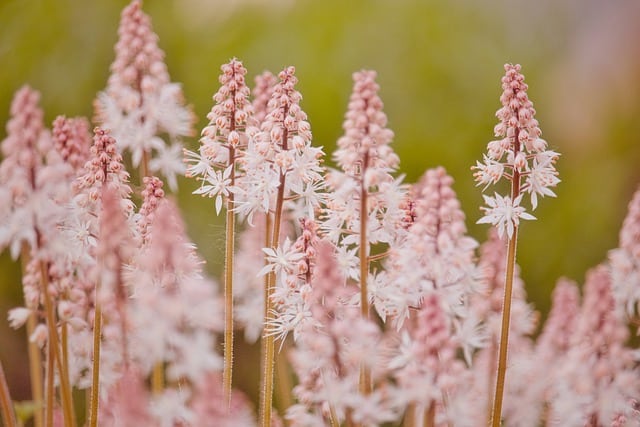
Foamflower, or Tiarella, is a charming, shade-loving perennial providing lovely white or pink blooms in the spring and summer. Its delicate foliage makes it an excellent ground cover for woodland gardens or shaded areas.
These plants prefer partial to full shade and tolerate moist, well-drained soil. Their height usually ranges from 6-12 inches, making them a perfect choice for borders or as an underplanting for taller flowers. Foamflower not only adds color but can also thrive in difficult garden conditions.
Gaillardia

As previously mentioned, gaillardia, or blanket flower, is cherished for its remarkable colors and ease of care. This flower can handle droughts, making it an attractive option for gardeners seeking resilience and beauty.
Gaillardia enjoys full sun and well-drained soils, producing stunning blooms that can be red, yellow, or a mix of both. With a height of 12-30 inches, it serves beautifully in borders or as part of a mixed perennial bed. The blooms encourage pollinators, ensuring an active garden ecosystem.
Garden Phlox
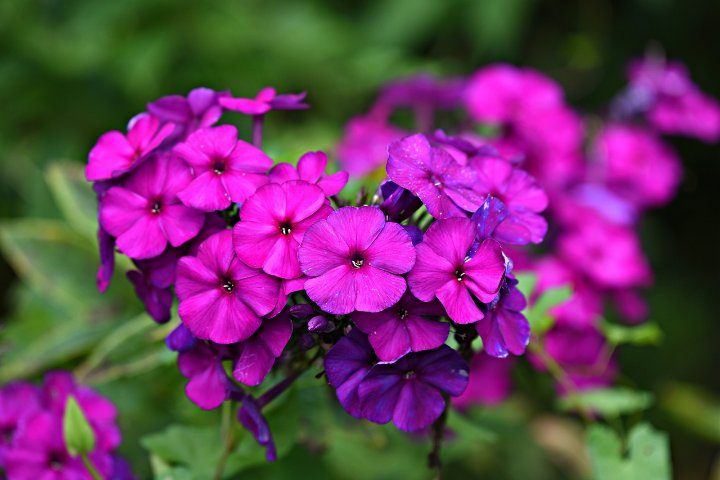
Garden phlox is a staple in many cottage gardens, offering sturdy, colorful blossoms that sway beautifully in the wind. Available in shades of pink, white, red, and purple, this perennial is sure to bring lively color to your July garden.
Plant phlox in well-drained soil and full sun for optimal growth and flowering. With mature heights ranging from 2-4 feet, garden phlox can serve as a stunning focal point. Regular deadheading encourages continuous blooms, ensuring your garden remains vibrant throughout the summer.
Hardy Geranium

Hardy geraniums are reliable performers in gardens, known for their lovely foliage and delicate blooms in various colors such as blue, pink, white, and purple. They are tolerant of a range of soil types, making them easy to manage.
These perennials prefer full sun to partial shade, growing to heights of 12-24 inches. Hardy geraniums spread easily, making them excellent ground covers. They provide excellent contrast when planted alongside taller plants, offering layers of interest throughout the season.
Hardy Hibiscus
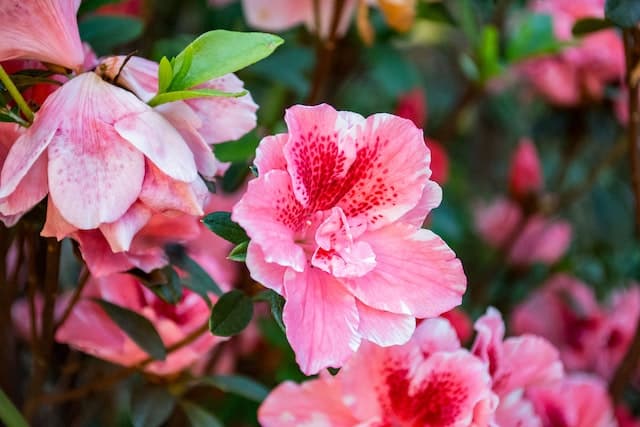
Bringing a tropical flair to your garden, hardy hibiscus offers large, eye-catching blooms that can reach up to 12 inches across. These plants are renowned for their vibrant hues, adding drama and excitement to the garden space.
Plant hardy hibiscus in full sun and ensure the soil is consistently moist for the best bloom. With a height of 36-60 inches, they can serve as a grand backdrop in garden beds. The large blossoms attract pollinators and serve as a stunning focal point for anyone passing by.
Hollyhocks

Hollyhocks are vintage garden favorites, evoking a sense of nostalgia with their tall stalks adorned with numerous blooms. They thrive in a range of colors, from soft pastels to vivid shades, showcasing their adaptability.
Their preference for full sun and well-drained soil makes them easy to grow in many settings, reaching heights of 5-8 feet. Plant them in the back of borders or against a fence for visual impact. Be prepared for hollyhocks to self-seed, providing surprise blooms in successive years.
Lamb’s Ear

Lamb’s ear is recognized for its silvery, fuzzy foliage, which adds a unique texture to your garden. While the plant features lavender blooms during late spring to early summer, its foliage remains an attraction throughout the growing season.
This perennial excels in full sun and well-drained soils, creating a low-maintenance option for various landscapes. Lamb’s ear grows to about 12-24 inches, making it a perfect ground cover or border plant, ideal for adding softness alongside sturdier flowers.
Lantana
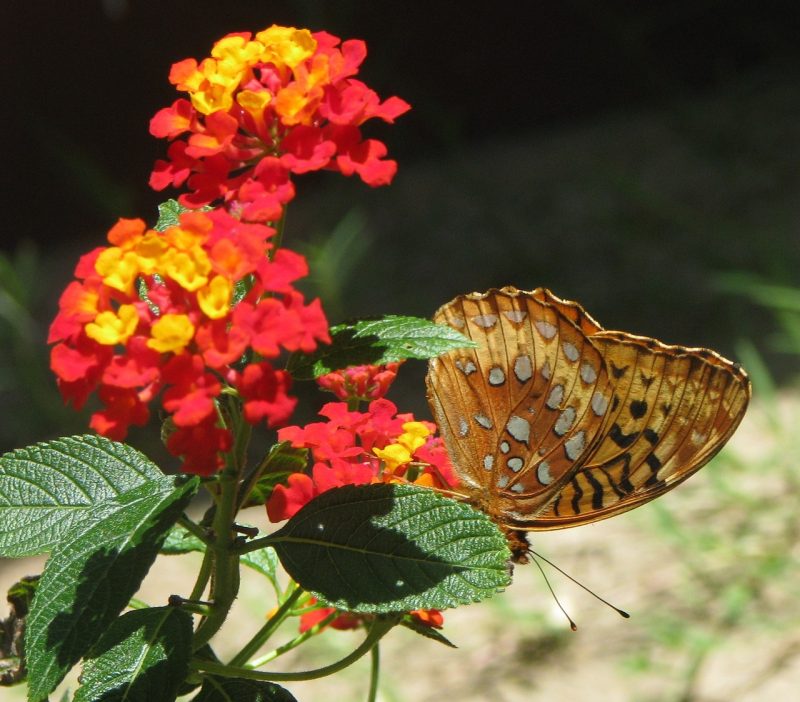
Lantana is celebrated for its vibrant flower clusters, attracting butterflies and hummingbirds to your garden. Their adaptability, and ability to thrive in hot weather make them perfect for July plantings.
Lantana prefers full sun to partial shade and well-drained soils but can tolerate various conditions. It can grow into a bushy size of 12-36 inches, making it a great choice for borders or as a colorful hedge. In warmer climates, lantana can show off its blooms throughout the summer and into fall.
Lavender (Lavandula spp.)
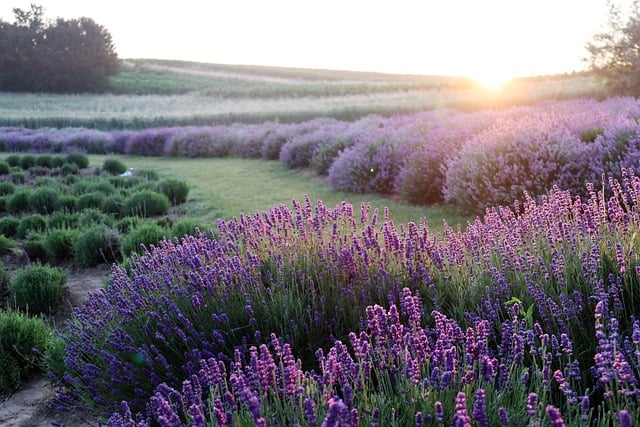
Lavender is a classic favorite known for its fragrant purple blooms and versatility in cooking, crafts, and natural remedies. Its calming scent and vibrant color make it a wonderful addition to any garden.
Lavender thrives in full sun and well-drained soil, tolerating drought conditions once established. These plants generally grow between 12-36 inches tall, suitable for a variety of planting contexts. Regular pruning can help maintain its shape while encouraging healthy growth and prolonged bloom times.
Liatris

As mentioned, liatris, or blazing star, is a remarkable flower due to its unique spikes of purple blooms. Its tall stature and pollinator-attractive flowers make it a great asset for any summer garden.
Liatris thrives best in full sun and well-drained soils, growing between 2-4 feet tall. Their vertical growth offers excellent height variations in garden beds, often appearing charmingly alongside lower-growing perennials, ensuring a cohesive look in your garden.
Marigold
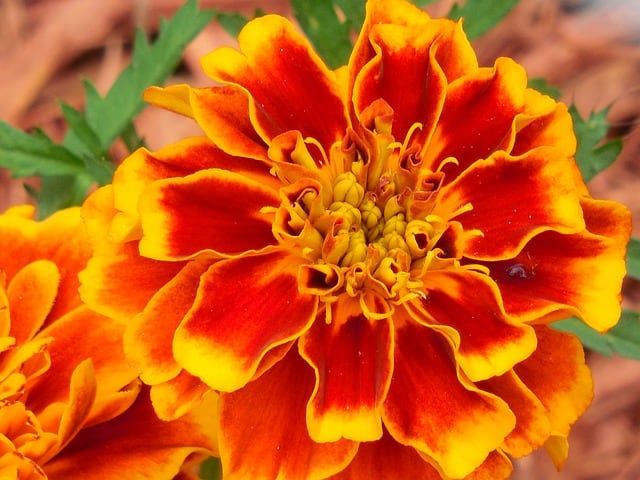
Marigolds are an annual flower that gardeners adore for their cheerful, sunny blooms and pest-repelling properties. Perfect for containers or borders, they add a touch of vibrant color that lasts throughout the summer.
Plant marigolds in full sun and well-draining soil for optimal growth. They typically range in height from 6 inches to 2 feet, depending on the variety. Pest-repelling properties make them valuable companions for vegetable gardens. Not to mention, their low maintenance needs make them perfect for new gardeners.
Mexican Bush Sage

Mexican bush sage, or Salvia leucantha, is a striking flower known for its silvery-green foliage and purple fuzzy spikes. This perennial adds drama and flair to gardens, all while attracting butterflies and bees.
It prefers full sun and well-drained soils, growing typically 2-4 feet tall. Mexican bush sage also prefers dry to moderate moisture levels, making it an ideal candidate if you’re looking for a drought-tolerant option while enhancing your garden’s aesthetic.
Morning Glories (Ipomoea purpurea)
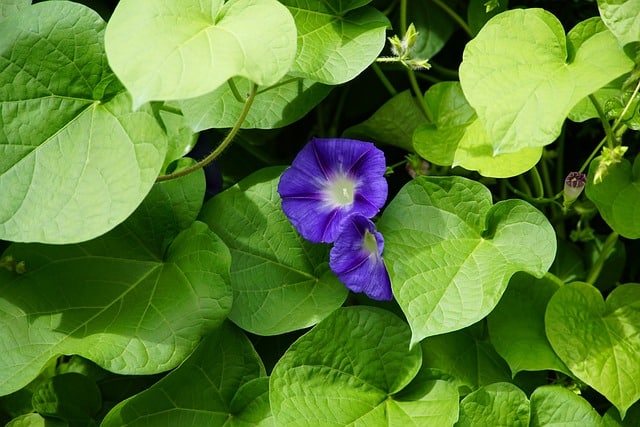
Morning glories are fast-growing vines that produce charming, trumpet-shaped flowers. These annuals can add vertical interest to your garden, climbing trellises, fences, or other supports with ease.
Choose a sunny spot with well-drained soil for morning glories, as they flourish in warm conditions. Typically, they bloom from summer to fall, with flowers opening in the morning and closing by afternoon. Ensure you provide a solid structure for them to climb as they reach 6-10 feet in height.
Moss Rose
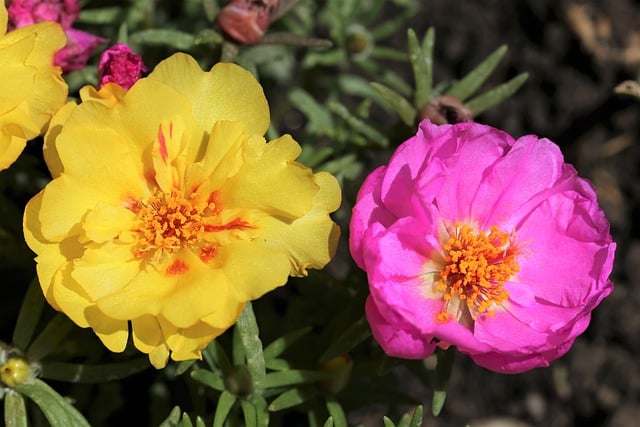
Moss rose, or Portulaca grandiflora, is perfect for gardeners seeking color with minimal maintenance. This succulent annual thrives in hot, sunny conditions, showcasing vibrant flowers in various hues.
These plants prefer well-drained soil and need little water once established. They grow low, about 6 inches tall, making them great for ground cover or borders. With a spreading habit, moss rose fills in gaps while attracting pollinators effortlessly.
Mountain Mint

Mountain mint is a lovely perennial with fragrant foliage and tiny white or purple flowers that offer a subtle visual appeal. Their aromatic nature makes them suitable for herb gardens and pollinator-friendly spaces.
Mountain mint prefers full sun to partial shade and well-drained soil. It typically grows between 2-3 feet tall and can often spread, forming dense clumps. This plant is an excellent candidate for eco-friendly gardens as it attracts various pollinators while being resistant to pests.
Nasturtium (Tropaeolum majus)
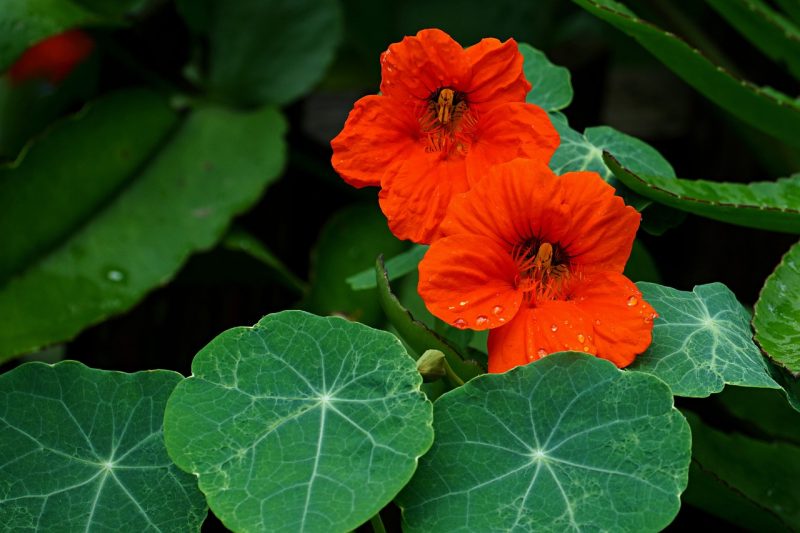
Nasturtiums are delightful annuals that introduce cheerful color and a unique peppery flavor to the garden and your plate. With flowers ranging from bright yellows to deep reds, these edible blooms can brighten salads or serve as garnishes.
They thrive in full sun and well-drained soils, though they do well even in poor soils, adding to their appeal for low-maintenance gardens. Nasturtiums spread and can trail between 12-36 inches, making them excellent additions to hanging baskets or as ground cover.
Pachysandra
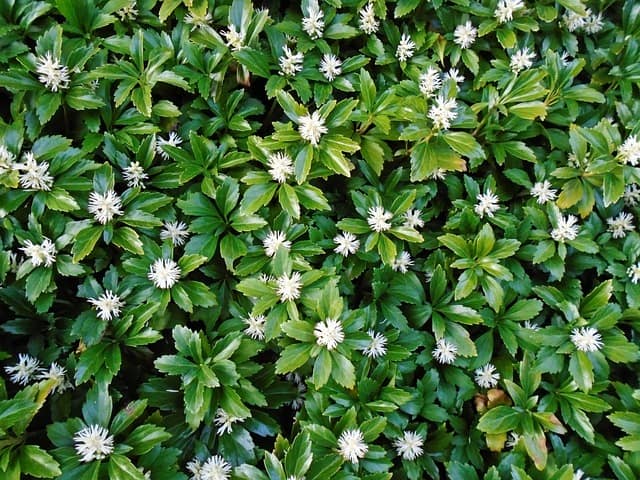
Pachysandra, often used as a ground cover, excels in shady areas where it thrives in well-drained soils. Its evergreen foliage offers year-round interest, providing a lush green backdrop for seasonal blooms.
This perennial is very low-maintenance, reaching heights of just 6-12 inches. It’s particularly effective for controlling weeds in shaded areas or as an underplanting option, creating depth and texture in the garden.
Pansies (Viola × wittrockiana)
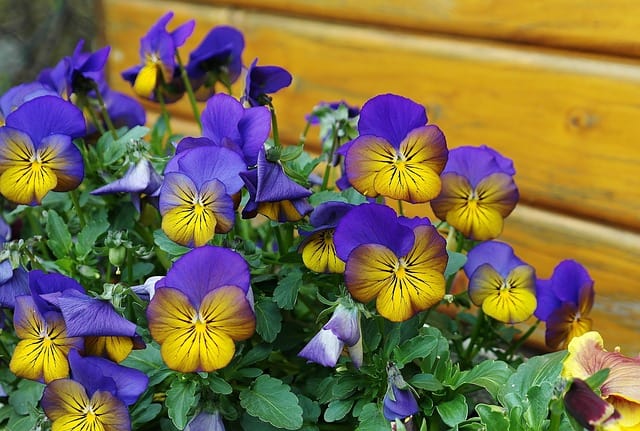
Pansies are beloved for their cheerful, wide blooms that come in a spectrum of colors, often with charming face-like patterns. They are perfect for adding early summer splendor as they can be planted from late spring through early summer.
They thrive in full sun to partial shade, preferring well-drained soils. With a height of approximately 6-12 inches, they work well in borders or containers, making them ideal for smaller spaces or adding pops of color throughout your garden.
Pentas

Pentas flowers, also known as star flowers, are tropical annuals that bring vibrant color while attracting butterflies and hummingbirds to your garden. Available in hues of red, pink, white, and lavender, they are sure to brighten up any landscape.
Pentas perform best in full sun and well-drained soils, growing around 18-24 inches tall. Regular deadheading encourages continuous blooms, ensuring your summer garden is bursting with color. Their ability to thrive in heat makes them an excellent choice for long-lasting summer displays.
Portulaca (Portulaca grandiflora)
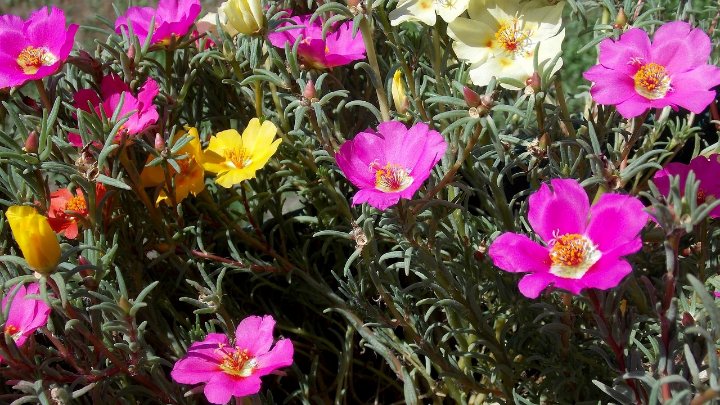
Portulaca, also known as moss rose, shares similar traits to its cousin, making it a perfect choice for gardeners who want vibrant blooms. This drought-tolerant annual features cheerful, succulent leaves and delightful flowers.
Plant portulaca in full sun and well-drained soil. Ranging from 6 to 8 inches in height, it’s perfect for rock gardens or hanging baskets. These low-maintenance plants add a bright touch to any summer landscape without demanding too much attention.
Russian Sage
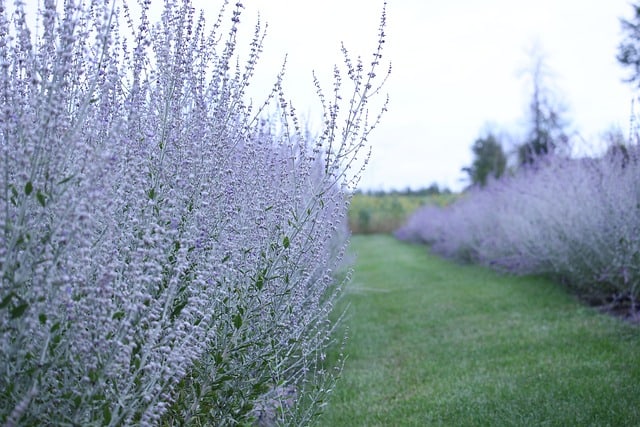
Russian sage is valued for its stunning silvery foliage and tall, airy spikes of lavender-blue flowers that create a romantic, wispy garden aesthetic. It operates beautifully as a backdrop or focal point in garden designs.
These hardy perennials thrive in full sun and are tolerant of dry conditions. Growing between 3-4 feet tall, Russian sage contributes a sense of movement with its delicate flowers waving in the breeze. Minimal maintenance makes it a favorite among gardeners seeking reliable beauty.
Salvia
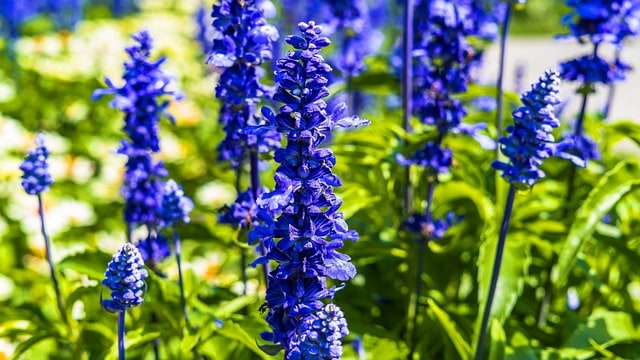
Salvia, or sage, represents an extensive family of flowering plants known for drawing in pollinators while providing low-maintenance beauty. Available in a spectrum of colors from blue to purple, salvia will bloom all summer long.
Choosing a spot in full sun with well-drained soil will yield the best results from salvia plants. They typically reach heights of 12-36 inches, making them excellent for borders or as part of mixed beds. These resilient plants thrive with minimal care, rewarding you with stunning blooms.
Solidago
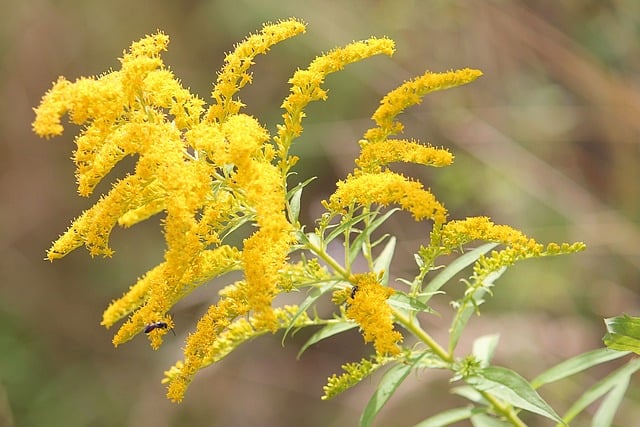
Solidago, commonly referred to as goldenrod, offers a glorious display of golden flowers that bloom in late summer and fall. These perennial plants are excellent for attracting pollinators and providing food sources for bees.
Goldenrod prefers full sun and well-drained soil, growing between 2-3 feet tall. Its durability and resilience in various conditions make it a perfect choice for wildflower gardens, bringing life and vibrancy to your landscape.
Sunflowers

Sunny and cheerful, sunflowers are a quintessential summer favorite that blooms profusely with their vibrant yellow petals. They can brighten up garden spaces and even serve as cut flowers.
Best planted in full sun and well-drained soil, sunflowers grow rapidly and can reach impressive heights of 3-10 feet, depending on the variety. They create an uplifting atmosphere and yield seeds that attract various bird species, enhancing the biodiversity in your garden.
Yarrow

Yarrow is a tough perennial with lush foliage and flat clusters of tiny flowers that can come in vibrant shades of yellow, pink, and white. Known for its resilience, yarrow flourishes with minimal attention.
Plant it in full sun and well-drained soil. Yarrow typically grows to a height of 2-3 feet, perfect for filling in garden beds or serving as a texture enhancer alongside other colorful perennials. It also offers medicinal qualities, making it a well-rounded addition to your summer garden.
Zinnia
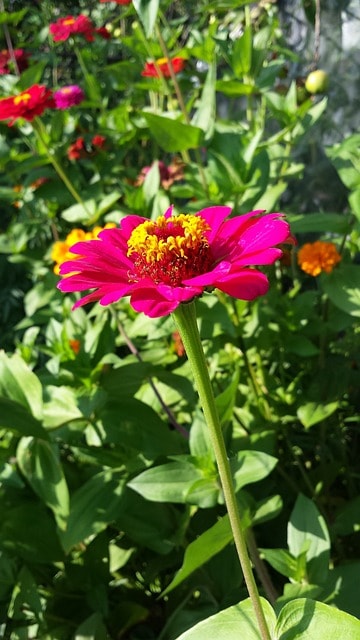
Zinnias are one of the most versatile and reliable annuals to plant in July. These hardy flowers are available in a wide array of colors and sizes, making them ideal for various garden styles. They thrive in the heat and continue blooming all summer long.
Growing best in full sun and well-drained soil, zinnias can reach heights of 1-3 feet. Their vibrant colors and long-lasting blooms make them perfect for borders, cutting gardens, or filling empty spaces in your landscape. They’re also low maintenance, making them perfect for beginner gardeners!





